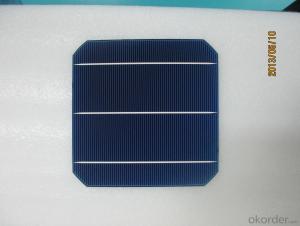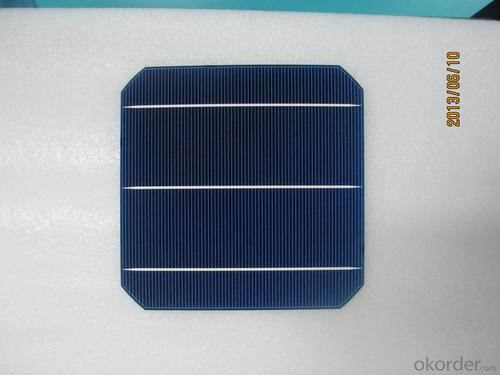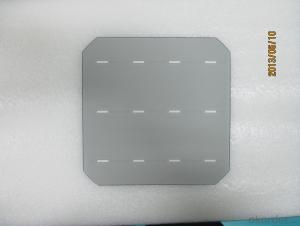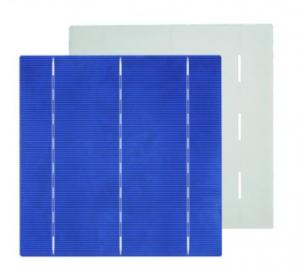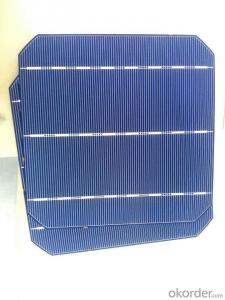Konarka Solar Cells - Monocrystal Solar Energy Cell 156*156mm with 18.6% Efficiency
- Loading Port:
- China Main Port
- Payment Terms:
- TT or LC
- Min Order Qty:
- -
- Supply Capability:
- 1000000 pc/month
OKorder Service Pledge
OKorder Financial Service
You Might Also Like

Monocrystal Solar Energy Cell
type:156M
appearance:156×1565㎜±0.5mm;diagonal:R=100mm
Main fence wide:1.4-1.5mm back electrode wide:2-2.5mm
Fence line qty:90
Cell thickness:220um±20um
Eff(%) | 18.00- 18.10 | 18.10- 18.20 | 18.20- 18.30 | 18.30- 18.40 | 18.40- 18.50 | 18.50- 18.60 | 18.60- 18.70 | 18.70- 18.80 | 18.80- 18.90 | 18.9- 19.0 | 19.1- 19.1 | 19.1- 19.2 |
Pm(W) | 4.30 | 4.33 | 4.35 | 4.37 | 4.40 | 4.42 | 4.44 | 4.47 | 4.49 | 4.52 | 4.54 | 4.56 |
Isc(A) | 8.71 | 8.73 | 8.76 | 8.77 | 8.78 | 8.82 | 8.83 | 8.85 | 8.86 | 8.88 | 8.9 | 8.93 |
Im(A) | 8.19 | 8.21 | 8.24 | 8.26 | 8.30 | 8.33 | 8.35 | 8.39 | 8.42 | 8.45 | 8.47 | 8.51 |
Voc(V) | 0.630 | 0.631 | 0.632 | 0.633 | 0.634 | 0.634 | 0.635 | 0.636 | 0.637 | 0.637 | 0.638 | 0.64 |
Vm(V) | 0.527 | 0.528 | 0.529 | 0.531 | 0.531 | 0.532 | 0.534 | 0.534 | 0.535 | 0.536 | 0.537 | 0.538 |
FF(%) | 78.6 | 78.7 | 78.8 | 79.0 | 79.2 | 79.3 | 79.5 | 79.6 | 79.8 | 80 | 80 | 80 |

remark:our company cells as per working current concentrate principle,separate the first and the second grade
Factory Picture of Solar Cells


FAQ
We have organized several common questions for our clients,may help you sincerely:
What’s price per watt?
A: It’s depends on the quantity, delivery date and payment terms of the order. We can talk further about the detail price issue. Our products is high quality with lower price level.
Can you tell me the parameter of your solar cells?
We have different series of cells with different power output, both from c-si to a-si. Please take our specification sheet for your reference.
How do you pack your products?
We have rich experience on how to pack the panels to make sure the safety on shipment when it arrives at the destination.
Can you do OEM for us?
Yes, we can.
How long can we receive the product after purchase?
In the purchase of product within three working days, We will arrange the factory delivery as soon as possible. The perfect time of receiving is related to the state and position of customers. Commonly 7 to 10 working days can be served.
- Q: What is the role of combiners in solar cell systems?
- The role of combiners in solar cell systems is to combine the electrical outputs from multiple solar panels into a single output, increasing the overall power output of the system.
- Q: How do solar cells handle electrical surges or lightning strikes?
- Solar cells are designed to handle small electrical surges or fluctuations in the electrical current, but they are not specifically designed to protect against lightning strikes. In the event of a lightning strike, the solar cells can sustain damage due to the high voltage and current associated with the strike. However, some solar installations include lightning protection systems or surge arresters that can help mitigate the risk of damage caused by lightning strikes.
- Q: How do solar cells handle hail or other severe weather conditions?
- Solar cells are designed to be durable and withstand various weather conditions, including hail and severe weather. They are made with sturdy materials like tempered glass or polycrystalline silicon, which can endure hailstorms without significant damage. Additionally, solar panels undergo rigorous testing to ensure their ability to withstand impact and extreme weather events.
- Q: Is silicon-based solar cells and silicon-based thin-film solar cells the same?
- General silicon-based solar cells refer to monocrystalline silicon and polycrystalline silicon solar cells, while silicon-based thin-film solar cells are similar to sunpower producing that type of battery that can be made into curved components.
- Q: What is the typical size and weight of a solar cell?
- The typical size of a solar cell ranges from a few square centimeters to several square meters, while the weight can vary from a few grams to a few kilograms, depending on the technology and application.
- Q: Can solar cells be used in underwater applications?
- Yes, solar cells can be used in underwater applications, but they require special design considerations.
- Q: What is the lifespan of a solar cell?
- The lifespan of a solar cell can vary depending on various factors, but on average, solar cells have a lifespan of around 25 to 30 years. However, with proper maintenance and care, solar cells can even last longer, sometimes up to 40 years or more.
- Q: What is the typical warranty for solar cells?
- The typical warranty for solar cells varies, but it is commonly around 25 to 30 years for the performance warranty and 10 to 15 years for the product warranty.
- Q: What are the different sizes of solar cells?
- Solar cells come in various sizes, ranging from small portable panels for charging devices to large-scale installations used in solar farms. The sizes of solar cells can vary based on the specific application and power output requirements.
- Q: Which brand of the solar cells is sold with the lower price on the market? Which brand is more practical for the countryside?
- The low price solar cells do not always mean lower quality, because sometime the government may provide the tax refund to support saving the energy.
Send your message to us
Konarka Solar Cells - Monocrystal Solar Energy Cell 156*156mm with 18.6% Efficiency
- Loading Port:
- China Main Port
- Payment Terms:
- TT or LC
- Min Order Qty:
- -
- Supply Capability:
- 1000000 pc/month
OKorder Service Pledge
OKorder Financial Service
Similar products
Hot products
Hot Searches
Related keywords
